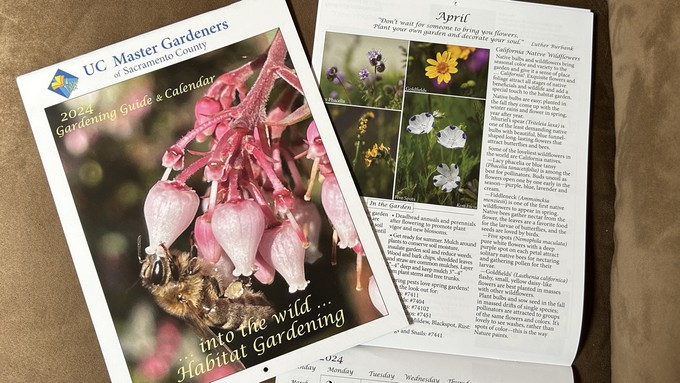
'Habitat Gardening' is the theme for the latest publication

The 2024 Gardening Guide & Calendar debuts Saturday at Harvest Day. Kathy Morrison
The Sacramento County master gardeners' Harvest Day event not only is a celebration of the current gardening year, it also brings a subtle reminder that the 2024 gardening year is not that far off.
That's because the next Gardening Guide & Calendar goes on sale for the first time during Harvest Day, this Saturday, Aug. 5, from 8 a.m. to 2 p.m. The new price for this invaluable publication is $12, slightly higher than in previous years to cover increased costs. But it's still a bargain, stuffed with monthly gardening tips, a Sacramento planting guide and lists of websites to UC research-based gardening information.
The theme of the 2024 publication is " ... into the wild ... Habitat Gardening," defined as plantings that feed, shelter and otherwise benefit insects, birds and other wildlife. Each month's calendar pages features information on important plants for wildlife -- from oaks in January to winter berries in December -- while the back section goes into more detail on how to "habitat garden." Here's a sample:
"Creating a habitat garden can be as simple or as complicated as you want, and can be done on any size lot. Convert a traditional landscape to attract and support wild creatures. All, like us, need food, shelter and water to survive. Habitat gardening will provide all of those whether we have a large garden, a strip of yard or a sunny porch."
The Gardening Guide & Calendar features gorgeous plant pictures, many by local master gardeners Jan Fetler, Roxie Jones, Greta Lacin, Pam Bone and Pat Schink. Edited by Laura Cerles-Rogers, it's written by Sacramento master gardeners for Sacramento-area gardens. (Full disclosure: I'm also a contributor to the publication.)
As usual, the Gardening Guide & Calendar will be available soon at area retailers and online, but the debut sale is always at Harvest Day -- with the added incentive of no tax or shipping costs.
Harvest Day takes place at the Fair Oaks Horticulture Center, 11549 Fair Oaks Blvd. in Fair Oaks, just south of Madison Avenue. For more on Harvest Day, which has both free admission and parking, see our other blog posts this week or go to https://sacmg.ucanr.edu/Harvest_Day/
Comments
0 comments have been posted.Sacramento Digs Gardening to your inbox.
Sites We Like
Garden Checklist for week of July 21
Your garden needs you!
* Keep your vegetable garden watered, mulched and weeded. Water before 8 a.m. to reduce the chance of fungal infection and to conserve moisture.
* Feed vegetable plants bone meal, rock phosphate or other fertilizers high in phosphate to stimulate more blooms and fruiting. (But wait until daily high temperatures drop out of the 100s.)
* Don’t let tomatoes wilt or dry out completely. Give tomatoes a deep watering two to three times a week.
* Harvest vegetables promptly to encourage plants to produce more. Squash especially tends to grow rapidly in hot weather. Keep an eye on zucchini.
* Pinch back chrysanthemums for bushy plants and more flowers in September.
* Remove spent flowers from roses, daylilies and other bloomers as they finish flowering.
* Pinch off blooms from basil so the plant will grow more leaves.
* Cut back lavender after flowering to promote a second bloom.
* It's not too late to add a splash of color. Plant petunias, snapdragons, zinnias and marigolds.
* From seed, plant corn, pumpkins, radishes, winter squash and sunflowers.